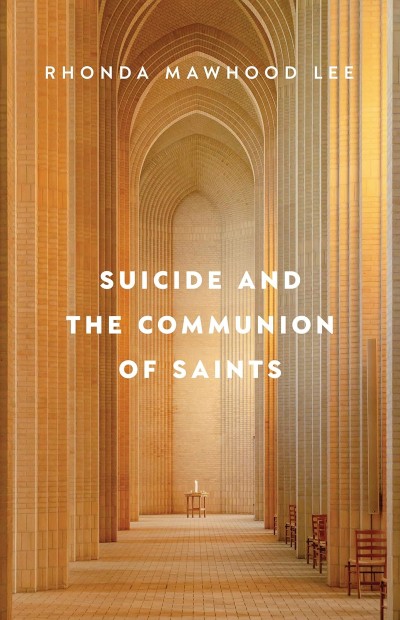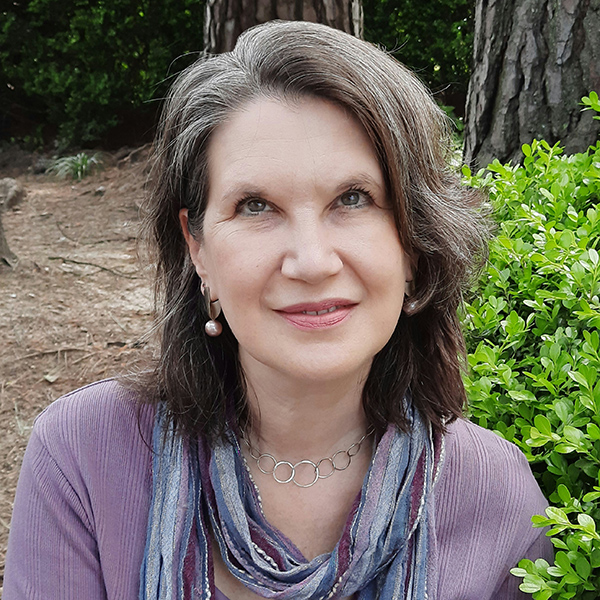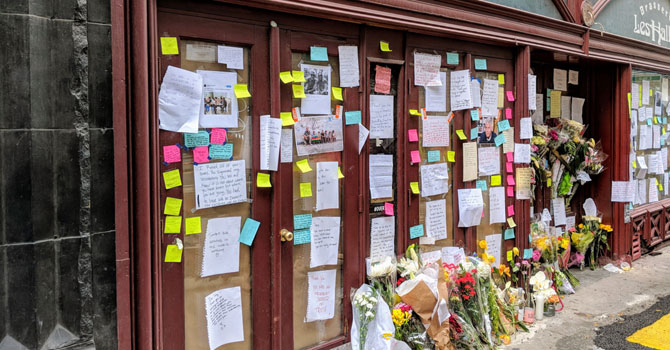If you or someone you know is in crisis, call the Suicide & Crisis Lifeline: Call, chat or text 988, a national, 24-hour service.
Rhonda Mawhood Lee’s life has been marked by suicide. Her mother killed herself when Lee was 28, after many years of depression and attempts. Later Lee learned that suicide had been a part of her family’s story for generations.
Her most recent book, “Suicide and the Communion of Saints,” draws upon Lee's personal experience as well as her training as a historian, Episcopal priest and spiritual director to offer a rigorous and compassionate exploration of suicide and its impact on those who survive.

In it, she rebuts harmful theology about suicide and suggests ways for Christians to support those affected by it, in part by employing the resources unique to the faith.
“I don’t believe suffering is God’s will. I do believe God can redeem our suffering. And when we suffer, I don’t believe we’re meant to suffer alone,” she said.
“That’s where the communion of saints comes in. Whatever burden we may have to carry, whatever our suffering, we are not meant to suffer alone.”
Lee spoke to Faith & Leadership’s Sally Hicks about her story and the ways in which harmful and unfounded beliefs about suicide still persist today. The following is an edited transcript.
Faith & Leadership: I noticed in the beginning of the book that you suggest using discretion in offering the book to others. That seems unusual in a book intended to help people. Why do you say that?

Rhonda Mawhood Lee: I deliberately called the foreword a “forewarning” rather than a foreword, and the copy editor thought I had made a mistake.
I hope that my book will be a helpful resource to a lot of people. And at the same time, for people who are freshly bereaved or who have just made an attempt, the effects may still be too raw for them to benefit from the book.
F&L: You divide this book up into two parts, and the first part is the history of Christian beliefs related to suicide. Aside from the fact that you’re a historian, why was it important to include that?
RML: I think it’s remarkable the extent to which very old ideas about suicide still have an impact on us.
I regularly watch movies or read books that express the idea that if you die by suicide, your insurance won’t pay out or you can’t be buried in a Catholic cemetery. And that’s just not true. For the cemeteries, that’s not true anymore. For life insurance, it is typically not true. These old ideas still have a hold on us. So that’s one thing.
The other thing is that sometimes it’s easier for us to look at a different period of time and say, “Oh, wow, that’s horrifying. What happened in the past is horrifying.”
Once we realize, “Oh gosh, people clearly got it wrong then,” we can then take that perspective and say, “OK, well then, what are we missing in our own time?”
F&L: Why is it important for people to be careful in the way they talk about suicide, including the language they use?
RML: I will never say someone “committed” suicide, because to use the word “commit” has a connotation that the person committed a sin or a crime or both. Suicide has long been considered a sin, and at times it has been a crime. In some places, it’s still a crime.
The language I advocate for is the same as the American Foundation for Suicide Prevention, whose guidelines for journalists are very helpful. I say that someone “died by suicide,” maybe “completed suicide” if we’re talking about attempts versus a completion. Or sometimes I’ll say, “killed himself,” which is I think somewhat more neutral.
F&L: And it’s not just the words but also how one speaks about it that is important.
RML: When my mother died, it was very important to be clear that, in fact, she had died by suicide. My life from my late childhood through to the present — or through to the time when she died, certainly — had been very marked by her depression and suicide attempts.
I knew in my 20s that part of the pain I had grown up with was due to the fact that my family could never acknowledge that my mother was depressed and suicidal, and I suffered greatly as a child because of that silence, that repression.
It was very important as an adult to be open about the fact that she had died by suicide. She didn’t try to cover it up, and she left a note. It was very clear what she had done. I felt like that was important for myself, for the journey of healing (not to be trite) that I knew I was now going to be embarking on, that continues 30 years later.
It’s the rationale for having support groups: You think you’re alone until you realize you’re not. For example, if I’m in a setting where someone bravely says, “My parent died by suicide” or “My child died by suicide,” I will usually say, “Yeah, me too. I’m also a survivor. My mother died that way.”
F&L: How long did it take you to get to that point? Was it something you had to work through?
RML: It was not. My friend told me my mother had died. When I called my aunt, I asked, “How did she die?” And my aunt said, “Well, it was suicide.” I said, “Oh, well, I thought it might be.” And she said, “Oh, really? Did you think so?”
People have all kinds of reactions. I don’t mean any disrespect to anyone, but I thought, “Are we talking about the same person? Because you knew her too. She was your sister.” But for me, I always knew that my mother might well die by suicide, and I was very open about it from the beginning.
F&L: What are the dangerous, unhelpful theologies that have persisted? What do you see as the problematic Christian thinking and response?
RML: For a long time, the predominant Christian thought about suicide has been that people who died by suicide would necessarily go to hell. Of course, not everyone believed this. But if you ask people for the classical Christian teaching about suicide, that would be it.
The problem with that really is that human beings presume to stand in the place of God. We presume to judge someone else. We all will stand before God one day and be judged by a merciful God who loves us.
The idea that suicide leads to hell came about through a reading of the writings of Augustine of Hippo and Thomas Aquinas, who were making other points.
I think Augustine and Thomas Aquinas would likely be quite distraught to discover some of the lengths to which their reasoning has taken people: people committing murder, for example, instead of killing themselves so that they might have the opportunity to confess and be absolved before being dispatched by the executioner.
They did believe that suicide was wrong. I think we can affirm that suicide is a damaging thing. It’s an indication that we live in a world marked by sin and death.
Yet Augustine, in large part, was trying to encourage women who were faced with or who had survived sexual assault in a context of war. He’s trying to convince them that if they were assaulted, their assailant’s sin did not mark them and that they should not sacrifice themselves as a result.
Sometimes I wonder if that point of Augustine’s had gotten the kind of play his words about suicide had gotten. How much better off would we be if we had said, “You know what? If you’re assaulted, it’s actually not your sin. It’s the assailant’s sin”?
Thomas Aquinas, likewise, was horrified by suicide. He was trying to keep people who had committed some other mortal sin like adultery, for example, from passing judgment on themselves and killing themselves. His point was, You are not judge, jury and executioner, and your immortal fate is not in your hands.
But, of course, there have always been people contesting these ideas. I think there have always been far more nuanced ideas about suicide and far more compassion for both the survivors, the people left behind by suicide who need compassion, but also for the person who died, than just a black and white reading of Augustine or Thomas would lead us to.
I also hope the book will be helpful to people who have been harmed by Christian theology around suicide. I hope that if someone is willing to trust a priest to have written this book, they might pick it up and find maybe a broader Christian imagination around suicide than what they experienced.
F&L: Why is the communion of saints — which is in the title of the book — so meaningful in talking about suicide?
RML: Suicide reminds us that the power of death is great. And yet Christianity affirms that the power of God demonstrated in the resurrection is greater. The power of Jesus Christ’s resurrection offers us a promise for after we’re dead, and also for this life.
It is easier for me as a person who is not suicidal to hold onto the power of the resurrection and to hold onto God’s promises. People who are in a suicidal crisis have a hard time holding onto that, finding hope. They are typically in great psychic pain and may also be in physical pain. Their focus often is very narrow. All they can feel is their pain.
There are two points I’d make. One is that the church needs to surround, as best we can, people at risk for suicide, and also survivors of suicide. And two: Be the presence of God’s love for them in imperfect human form. We can do this in very practical ways, like bringing casseroles, listening. There’s a whole series of things we could do.
I also think it’s important to remember that people who die by suicide are still members of the communion of saints. Catholic theologian Elizabeth Antus says this as well. They are still with us as ancestors, saints. Death does not break our ties with anyone, and why would people who die by suicide be any different?
F&L: One of the things that I thought was quite lovely was reimagining the image of God from a forbidding figure sitting in judgment of us.
RML: Jesus lived with the specter of death. Although he was executed, did not kill himself, he lived with the specter of death. I believe he knew what it felt like to have death stalking him.
So Jesus in the garden of Gethsemane, for example, or even Jesus on the cross, would be a faithful companion for someone for whom life is painful. So that’s a possibility.
Lauren Winner has a book called “Wearing God,” about different images for God from the Bible. I draw on her work to say, What might it be to imagine God being a fuzzy sweater we can curl up in?
The New Testament refers to being clothed with Christ and putting on the armor of God, which is great if you think you’re fighting a battle. The armor of God could be a very helpful metaphor for some people.
And yet, if we’re being clothed in armor, which Paul offered, maybe we’re also being clothed in a nice crocheted afghan that God made for us just as God sewed clothing for Adam and Eve as they were leaving the garden of Eden.
The Holy Spirit is, Jesus says, our advocate. If you’re feeling like you don’t deserve to live, an advocate could be a really good and helpful ally.
The person who is suicidal themself might or might not be able to reach for these. These are images that can be offered by people who are seeking to accompany someone in distress, and not to be stuffed down anybody’s throat. If they’re not helpful, they’re not helpful, but they could be offered.
F&L: As a priest, as a pastor, when someone comes to you and says, “How could God give me this pain?” what do you say? And, more generally, what can the church do?
RML: That’s so hard. The question of, Why do I suffer like this? Whatever the suffering is. Or, Why is the person I love suffering like this? Or, Why do I have to suffer because they’re suffering? Which comes up. Yeah, that’s really hard.
I would never say that someone’s suffering was God’s will. In a nutshell, what I believe is that suffering comes from living in this world that is profoundly marked by sin and death, and yet also marked by beauty and love and reshaped by the resurrection.
The question is then, How are we there for each other? One thing I think clergy and lay ministers can do is to speak openly and honestly about suicide, and with some humility. We’re not here to judge. We are here to accompany people with compassion. So that’s very important.
I do think we have resources that are not available in a secular context. We can pray with people. We can interpret Scripture together. We can turn to the Bible and affirm God’s love.
Then, God forbid, if someone does die by suicide, our funeral rites are there. Our mourning rites are there for us to sing together, read Scripture, pray, lay a person to rest, all of that. We have these resources that I think we really need to claim.
























